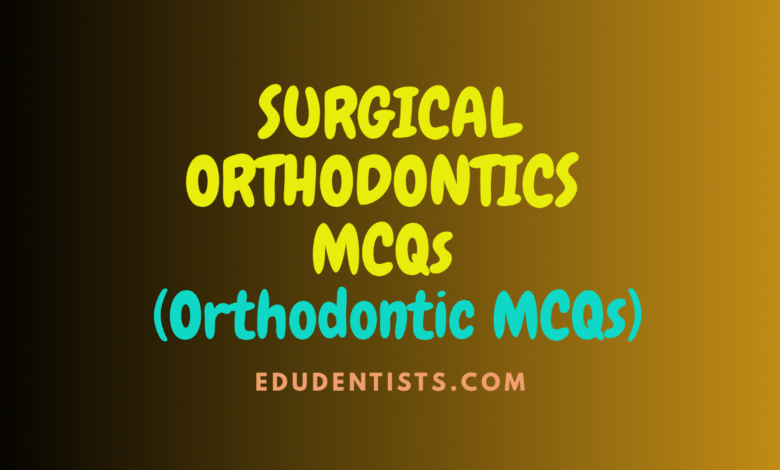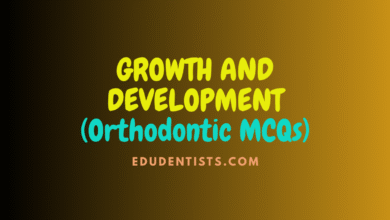
SURGICAL ORTHODONTICS MCQs – Ortho MCQs
SURGICAL ORTHODONTICS MCQs – Ortho MCQs
1. Best treatment for long face syndrome is:
A. Impaction of maxilla
B. Impaction of maxilla followed by mandibular surgery
C. Body osteotomy
D. BSSO
2. Condition in which vertical section of ramus of mandible is done is:
A. Mandibular protrusion
B. Mandibular retrusion
C. Maxillary prognathism
D. Maxillary retrognathism
3. What is the sequelae of bilateral sagittal split osteotomy?
A. TMD
B. Tinnitus
C. Altered sensation postoperatively
D. None of the above
4. Preferred procedure for mandibular advancement is
A. Bilateral sagittal split osteotomy
B. Le fort osteotomy
C. Trans oral vertical ramus osteotomy
D. Genioplasty
5. Skeletal deep bite is best treated surgically by:
A. Bilateral sagittal split osteotomy
B. Vertical ramus osteotomy
C. Le fort 1 superior repositioning of maxilla
D. Le fort 1 inferior repositioning of maxilla
6. Preferred surgical procedure for maxillary advancement is:
A. Vertical oblique ramus osteotomy
B. Bilateral sagittal split osteotomy
C. Le fort 1 osteotomy
D. None of the above
7. Widening the maxilla surgically is:
A. Stable
B. Least stable
C. Moderately stable
D. Stability cannot be predicted
8. Wassmund procedure is a treatment for:
A. Deep bite
B. Open bite
C. Skeletal class 3
D. Maxillary prognathism
9. Corticotomy involves:
A. Sectioning of abnormal frenum
B. Sectioning of supracrestal fibers
C. Sectioning of dentoalveolar bone into multiple small units to hasten orthodontic tooth movements
D. Cutting of maxillary tuberosity
10. Le fort 1 osteotomy is done for:
A. Maxillary retrognathism
B. Maxillary prognathism
C. Both of the above
D. None of the above
11. Type of reduction genioplasty in which incidence of ptosis is maximum is
A. Osteoplasty of chin protuberance
B. Vertical reduction osteotomy with wedge ostectomy
C. Lateral reduction with midline ostectomy for broad based chins
D. None of the above
12. What are the objectives of orthognathic surgery?
A. Function
B. Aesthetics
C. Stability
D. All of the above
13. Cosmetic surgery of chin is known as:
A. Rhinoplasty
B. Chinoplasty
C. Symphysioplasty
D. Genioplasty
14. Which categorization of age is most reliable for surgical orthodontics?
A. Dental
B. Physiological
C. Skeletal
D. Biological
15. Dental compensations to skeletal malocclusions are treated:
A. Prior to surgery
B. After surgery
C. During surgery
D. None of the above
16. Which of the following is the major indication for orthognathic surgery before puberty is?
A. Transverse deficiency of maxilla
B. Ankylosis of mandible
C. Prognathic mandible
D. Prognathic maxilla
17. Crossbite to narrow maxilla is best treated surgically by:
A. Only slow maxillary expansion
B. Only rapid maxillary expansion
C. Surgically assisted rapid maxillary expansion
D. Surgically assisted slow maxillary expansion
18. The best material for alveolar bone grafting is:
A. Cancellous bone
B. Autogenous bone graft
C. Heterogenous bone graft
D. Hydroxyapatite crystal
19. Impaired growth after surgical correction of cleft lip and palate is due to:
A. Periosteal stripping
B. Scar formation
C. Interferences with blood supply
D. Combination of the above
20. Ideal time for grafting alveolar bone is:
A. During lip repair
B. At the age of 5 years
C. During palatal repair
D. At the age of 8–9 years
21. A minor surgical procedure that is most commonly undertaken in conjunction with orthodontic treatment is:
A. Extraction
B. Frenectomy
C. Pericision
D. Edward procedure





